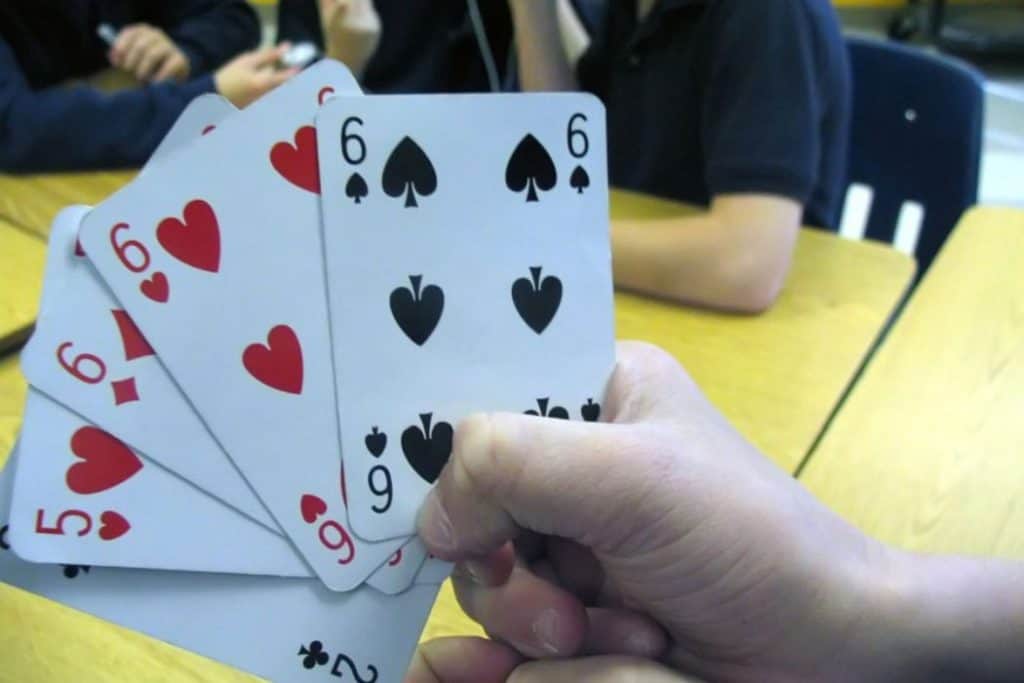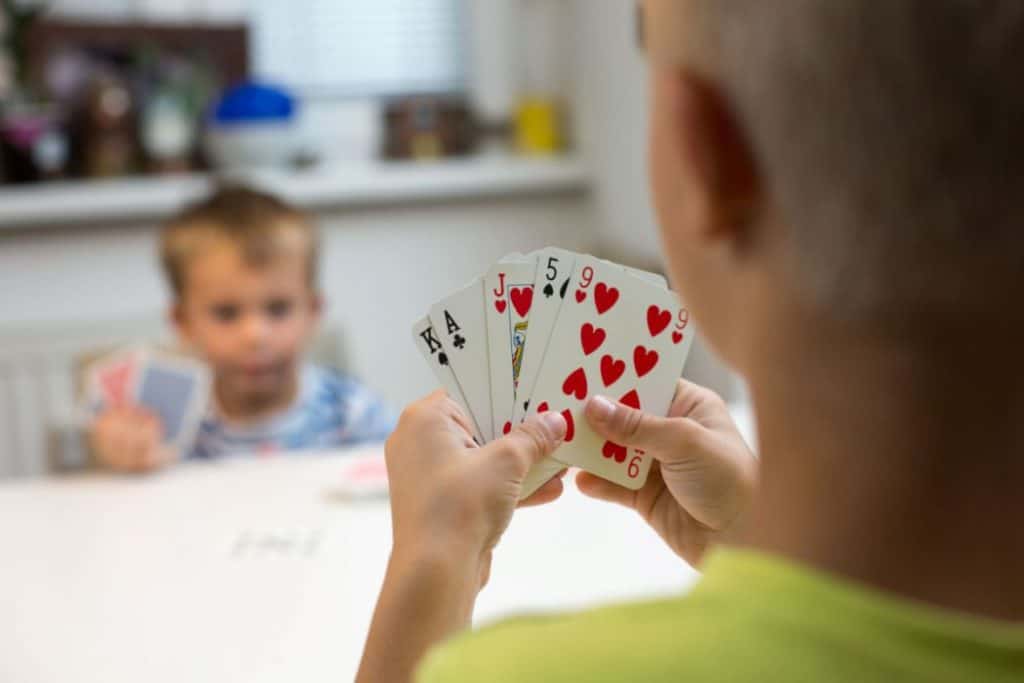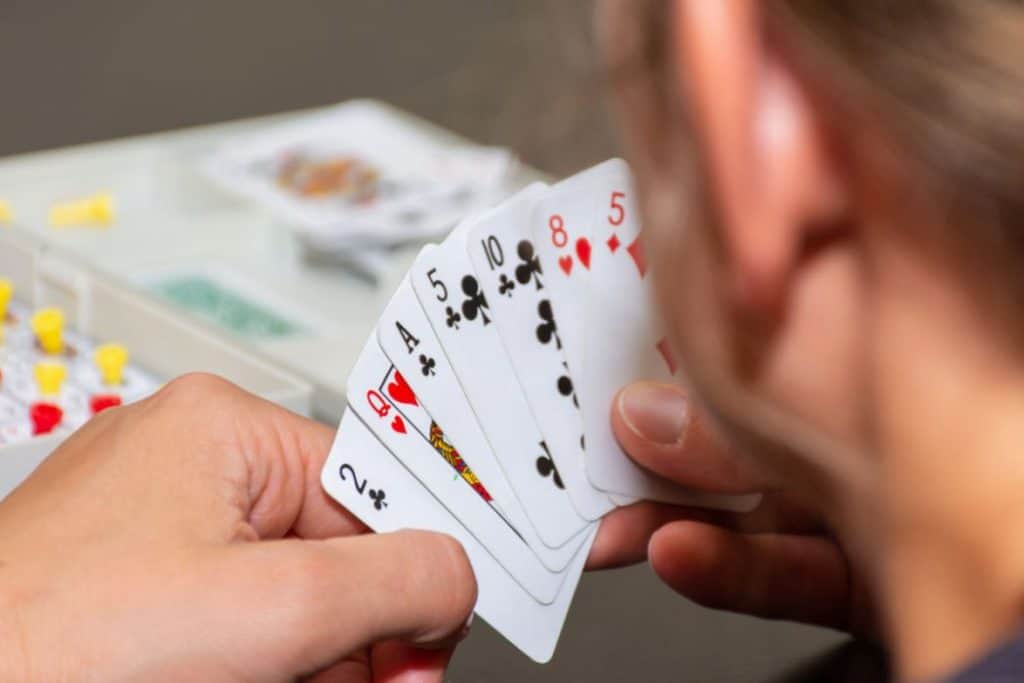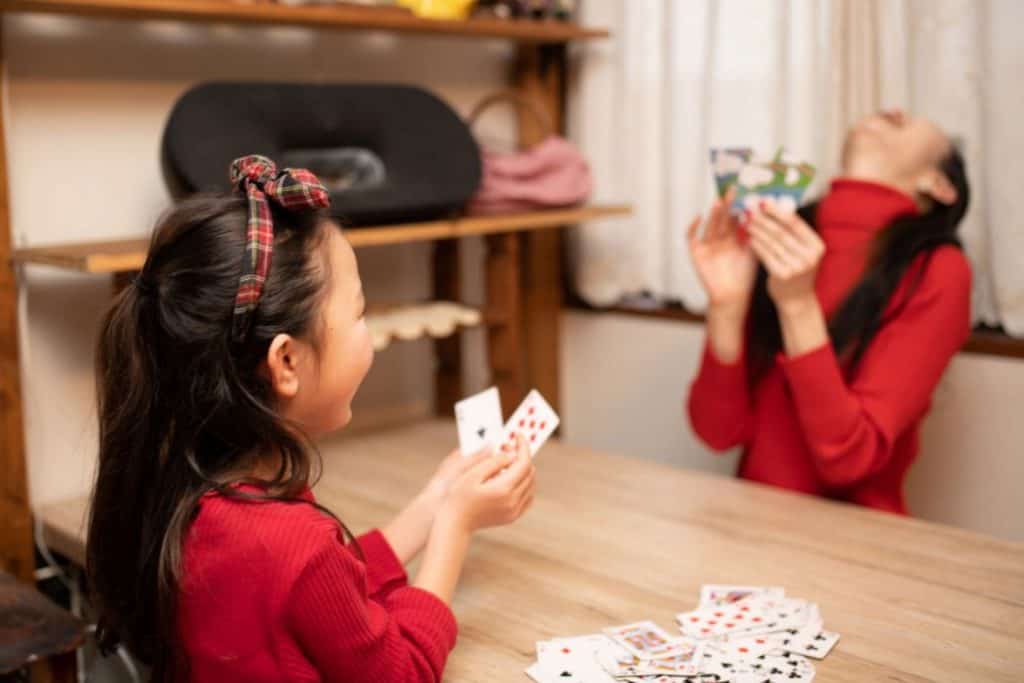Children often get bored easily. Luckily, these dearly loved humans are equally as easy to entertain and keep engaged.
Whether you are dealing with toddlers, pre-schoolers, or older school-going children, there is no shortage of easy card games to keep them engaged during a sleepover or rainy day. The best part about card games is that they are fun and educational in equal measure.
Whether you are hoping to build their social skills or teach them shapes or strategy, or simply have fun, these easy card games will do the trick.

1. Go Fish
Ideal for children aged: 6 and above
Number of players: 2 to 4
How to Play
Shuffle the cards and deal them out to each game player — having one child play “dealer” will make the game even more interesting for them. Here is a guide to how many cards to give each player.
| Two players | 7 cards each |
| Three players | 6 cards each |
| Four players | 5 cards each |
Randomly place the remaining cards on the table with their values concealed — this becomes the game’s fishpond.
With every player secretly examining their cards, the first player — usually on the dealer’s left side — should choose one of the remaining players and ask them for cards of the value of their choosing.
For instance, the first player can ask their chosen counterpart for sixes, kings, or hearts. As a rule, however, a player must already have the cards they are asking for among their given cards.
That is, one can only ask for spades if they already have spades in their cards.
The requested player should hand over the requested cards and the first player will take another turn asking for cards of another value.
This should go on until the chosen player is unable to offer the requested cards.
If the chosen player does not have cards of the requested value, they must give the first player the cue to “Go Fish.”
Then the first player must pick a card from the deck on the table or fishpond.
The player who gave the “Go Fish” cue becomes the second player or the requester.
A player will only win Go Fish if they collect up to four cards of the same value.
These become part of their winner’s pile.
This will go on until all players have won all four sets of each value. Essentially, the overall game winner will have collected more sets of four or has only complete sets instead of single cards.
2. Snap
Ideal for children aged: 6 and above
Number of players: 2 to 6 (more enjoyable with at least 3)
How to Play
You can choose to play this game with Snap-themed cards, or you can go with traditional cards.
That being said, playing the game with themed cards is especially enjoyable for children because you can purchase cards whose themes align with their interests and personalities.
As is the case with all card games, deal the cards to each player until no cards are left, and have them place their piles face down in front of them.
Keep in mind that some players might have more cards than others.
With the players seated in a circle, choose the first player and have them start a pile of cards by flipping the card at the top of their pile and placing it at the center of the table face-up.
The first player should be on the dealer’s left hand.
The second player —- moving counterclockwise — should follow and add to the face-up pile at the center by flipping the card at the top of their pile.
This goes on until the first player to notice two matching cards in the face-up pile shouts “Snap” and wins the entire face-up pile. Any player who runs out of cards loses.
Alternatively, the players can flip the top cards on their face-down pile and build a face-up pile next to their first pile. This way, each player will have two card piles — a face-down one and a face-up one.
The first player to notice matching cards in any of the face-up piles wins the matched piles and adds them to their face-down stack.
The two or more players who shout “Snap” at the same time will form a shared “snap pool” at the center of the table.
The game will continue until a flipped card matches the top of the “snap pool” card and a player shouts “snap pool” to win.
To encourage concentration, you can set rules that any player who mistakenly shouts “snap” either:
- Gives up his entire face-down deck to become the new snap pool or
- Offers each player a card from their face-down stack
To further increase engagement, you can make rules requiring the players to make the respective animal sound on the matching cards in addition to shouting Snap.
This is only applicable when using animal-themed cards.
In addition to shouting ‘Snap’, a player can also place their hand on the face-up pile at the center of the table for the first variation.

3. Slapjack
Ideal for children aged: 6 and above
Number of players: 3 to 6
How to Play
Shuffle the cards and have one of the players deal the whole pack to the other players, who then place them in face-down piles.
Starting with the player on the dealer’s left, the players should take turns flipping the cards at the top of their face-down pile to create their face-up pile. As a result, each player will end up with two card piles.
The game continues until one player flips over a jack and then all the other players should try to be the first ones to place their hand over the jack pile and yell “Slapjack!”
The first player to slap the jack wins the stack and adds them to their face-down pile. Shuffling the cards at this point will help keep the game more unpredictable.
In case a player mistakenly slaps a card that is not a jack, they must then offer a card to the player whose card they mistook.
The game continues with every player flipping their card and trying to win.
Any player who runs out of cards has one chance to redeem themselves when a counterpart plays the next jack. Otherwise, they are out of the game.
The winner of Slapjack is the last man standing.
4. Beggar My Neighbor
Ideal for children aged: 6 and above
Number of players: 2 to 6
How to Play
A team of four or more players will need at least two packs of cards.
First, have the players choose a dealer to distribute all the cards among them. The player should not look at their cards — they should be in face-down stacks the entire time.
Next, the first player flips over the top card on their deck and places it face-side-up at the center of the table. This goes on until a player flips over either an ace, queen, king, or jack.
Depending on the card played, the player must then demand the next player — usually the player on their left — to play a specific number of cards. For instance, the next player should play:
- Four cards for an ace
- Three cards for a king
- Two cards for a queen
- One card for a jack
The requested player must then start adding the required number of cards to the face-up pile on the table after which the game will continue.
However, if among the cards played are kings, aces, jacks, or queens, the player must then stop and ask the next player to play the expected number of cards.
Whoever turns over an ace, jack, king, or queen last should then pick up the face-up pile for the play to resume.
The winner is whoever runs out of cards first. Keep in mind that whether a player wins or loses is determined by the cards they are dealt — their fate is already decided but it is still so much fun to play.

5. Pig
Ideal for children aged: 10 and above
Number of players: 4 to 13
How to Play
Pig is a great game to play when you have large groups of children.
You can use any set of cards as long as it has groups of four of each value. The standard card set or Happy Family cards will do.
First, arrange the cards into groups of four cards each. This way, each player will have a single set with four cards only. For instance, a group of five players should have 20 cards in rotation.
Next, shuffle the cards and deal them out to each player.
The game begins with each player passing one of their cards to the player seated on their left while they receive one themselves from the player on their right.
This goes on in a fast and rhythmic manner to build momentum and keep the game enjoyable until one player collects four cards of the same kind — that is four jacks or four queens and so on.
At this point, the player in question stops passing cards and he or she places a finger on their nose.
Once this happens, the other players must be attentive enough to notice, stop the card passing and place fingers on their noses too even if they do not have four matching cards.
The last player to do this is the pig – and loses the game.
6. Old Maid
Ideal for children aged: 6 and above
Number of players: At least 2
How to Play
Begin by removing one of the queens from the card deck before dealing the remainder evenly among all the players. It is okay if some players have one or two extra cards.
Next, have each player remove all the pairs present in their dealt cards. For example two aces, or sixes and place them face-down by their side.
This is even if a player has more than two cards of the same kind.
The player on the dealer’s left then takes a card from the dealer’s pair and tries to make a pair with their cards.
If they can make a match they can then pass their remaining cards to the player on their left who then takes one and tries to make a pair.
The game goes on until all the cards are paired up except one. The player holding the unmatched card is the winner — the Old Maid.

7. Snip, Snap, Snorem
Ideal for children aged: 6 and above
Number of players: At least 3
How to Play
Choose a dealer to evenly distribute the cards among all the players — some might have a few more than others.
Next, have each player arrange their cards in numerical order — that is, ace to king to make the game simpler. Now have the first player randomly place a card on the table.
The player on their left should then check to see if they have cards with the same number in their pile. If they do, they should place them next to the first card and say ‘Snap’ while doing it.
The player placing the third card of the determined value should say “Snap” while the last player with the final card should say “Snorem.”
The player with the final card — the ‘Snorem’ should then randomly place another card and start the game all over again.
Keep in mind that the game goes on if a player lacks any card of the given number at any point.
The winner is the first player to go through all their cards.
8. Memory
Ideal for children aged: 8 and above
Number of players: At least 2
How to Play
Depending on the surface the children are playing on, spread a pack of cards face-down in a single layer.
Choose the first player and have them flip two cards randomly in front of the other players. If the flipped cards are a match (for example, two sixes), the player can keep them as their pile.
If the cards are not a perfect match, the player must flip the cards face-down as the game proceeds to the player on the left — always move counterclockwise.
The winner in this game is the player with the most pairs at the end of the game.
9. Top Trumps
Ideal for children aged: 6 and above
Number of players: At least 2
How to Play
Have a dealer distribute Top Trump cards to all the players, keeping them face-down to hide their value. You can get Top Trumps cards on Amazon.
Next, have the participants hold their cards in such a way that they can only see the card’s top.
The player on the dealer’s left should start the game by reading out loud the statistic or numeric value at the top of the card.
The game goes on with every player reading out the number on the top of their cards.
This happens until a player reads out the highest number in the group and wins the top cards of all the other players and adds them to their pile.
The winning player then kicks off the game again by reading out another statistic on a new card.
If several cards share the highest value, the players place all the cards on the table and the same player chooses a new card to start the game all over.
In the end, the winner is the player with all the cards.
10. Predictions
Ideal for children aged: 6 and above
Number of players: 2 to 3
How to Play
Deal the cards among all the players present and then have them flip and place the cards at the top of their piles on the table.
The goal of Predictions is to have the players guess values before they flip their cards over.
Essentially, they should say out loud a number or value that their next card will NOT be.
It is okay if a player repeats the same number several times or even says a number or value that has already been said.
However, a player is out of the game if they call out a number that matches the one on the card.
The goal is for the players to go through their card piles without correctly predicting any.

Tips for Playing Card Games with Kids
While the card games highlighted here are easy enough for kids to play, here are a few foolproof tips to make the experience even more enjoyable for them.
Teach Them the Rules
Starting with a practice round where experienced players can talk the new ones through the rules of the game will help warm up the newbies to the game.
The best way to do this is to have several open rounds so all players can see each other’s cards.
Decide Who Goes First
Announce from the start how you will decide who takes the first turn to avoid fights as the games go on. Here are smart ways to make the decision:
- The person on the dealer’s left goes first — keep it fair by switching up the dealer every time
- The youngest always plays first
- The player with the highest number in a die throw goes first
- Distribute cards and the player with the highest card value takes the first turn
Make the Games Easier by Building Confidence
The best way to make the games easier for younger and new players is by building their confidence. You can do this by reducing the number of cards each player holds making them less overwhelmed.
Additionally, using the right cards will help make the games easier. You can play the card games in this list with standard cards but themed cards will be a better fit in some cases.
Final Thoughts
Card games will always get the job done as far as keeping kids distracted goes.
The best part is that you can modify these games to suit both older and younger players, as well as experts and novices.
All in all, this list adds to your mom, dad, aunt, or uncle hacks to give kids a fun time.
Resources:
- https://wehavekids.com/parenting/Card-Games-For-Kids
- https://www.todaysparent.com/family/activities/10-kid-friendly-card-games/
- https://www.itsalwaysautumn.com/11-fun-easy-cards-games-for-kids-and-adults.html
- https://www.mentalup.co/blog/card-games-for-kids
- https://www.netmums.com/activities/easy-card-games-for-kids
- https://www.weareteachers.com/fun-card-games/
- https://brisbanekids.com.au/6-easy-card-games-kids/




